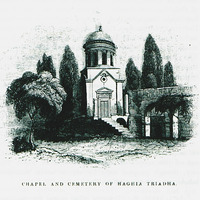Μονή της Αγίας Τριάδας των Τζαγκαρόλων
Αντικείμενο
Τίτλος Σημείου Ενδιαφέροντος
el
Μονή της Αγίας Τριάδας των Τζαγκαρόλων
en
Monastery of Agia Triada Tzagarolon
Περιγραφή / Απόσπασμα
69-73
en
The road from this spot to the monastery of Haghia Triádha" runs near two or three villages, without entering into any of them. The part of the Akrotéri over which it passes is generally uncultivated, and seems to be barren. There is a great abundance of game, espe cially red-legged partridges, on it. Haghia Triádha is surrounded by many lofty cypresses, a long avenue of which leads up to the principal entrance of the monastery. The Hegümenos is a venerable and communicative old man, with whom I had much conversation.
Παρατηρήσεις
el
Ο συγγραφέας συναντά τον ηγούμενο ο οποίος τον πληροφορεί ότι η μονή δεν ανοικοδομήθηκε πλήρως λόγω της κατάκτησης του νησιού από τους Οθωμανούς. Πριν την Επανάσταση η μονή αριμούσε περί τους 40 μοναχούς, ενώ τώρα είναι ελάχιστη. Στη μονή ο Pashley δοκιμάζει τον τοπικό οίνο, τον οποίο βρίσκει "άριστο". Όπως αναφέρει, το κρασί και το αμπέλι της αρχαίας πόλης των Κυδώνιων ήταν τόσο καλό ώστε να κοσμεί τα νομίσματα τηε εποχής.
en
The author meets the abbot who informs him that the monastery was not completely rebuilt due to the conquest of the island by the Ottomans. Before the Revolution the monastery numbered about 40 monks, while now it is minimal. At the monastery, Pashley tastes the local wine, which he finds "excellent". According to him, the wine and the vineyard of the ancient city of Kydonia were so good that it adorned the coins of the time.
Σύγχρονη περιγραφή
el
Η Μονή της Αγίας Τριάδας των Τζαγκαρόλων βρίσκεται στη χερσόνησο Ακρωτήρι, περίπου 15 χιλιόμετρα από την πόλη των Χανίων και είναι Σταυροπηγιακή, που σημαίνει ότι η διαχείριση της γίνεται άμεσα από το Οικουμενικό Πατριαρχείο. Πρόκειται για ένα από τα πιο σημαντικά μοναστηριακά συγκροτήματα του τέλους της Βενετοκρατίας στην Κρήτη. Το 1611 οι βενετσιάνικες αρχές των Χανίων ανέθεσαν στον ιερομόναχο Ιερεμία Τζαγκαρόλο την ανασυγκρότηση της παλαιότερης μικρότερης μονής των Μουρτάρων που υπήρχε εκεί. Ο Ιερεμίας καταγόταν από ενετοκρητική οικογένεια και ήταν γνωστός λόγιος της εποχής με σπουδαία μόρφωση και ισχυρή επιρροή τόσο στον Ορθόδοξο πληθυσμό όσο και στους Καθολικούς Βενετούς. Σχεδίασε και έκτισε το μοναστηριακό συγκρότημα, βασιζόμενος στα βιβλία του Ιταλού αρχιτέκτονα Σεμπαστιάνο Σέρλιο. Μετά το θάνατό του, οι εργασίες συνεχίστηκαν από τον αδερφό του Λαυρέντιο, διακόπηκαν όμως το 1645, όταν οι Οθωμανοί κατέλαβαν τα Χανιά. Κατά τη διάρκεια της Τουρκοκρατίας το Μοναστήρι πήρε το όνομα Selvili Manastır, δηλαδή το Μοναστήρι με τα κυπαρίσσια. Στη διάρκεια της επανάστασης του 1821 η μονή κάηκε από τους Οθωμανούς, ενώ εννιά χρόνια αργότερα ανασυγκροτήθηκε και ολοκληρώθηκε με οικοδομικές εργασίες που αφορούσαν την κατασκευή του τρούλου του καθολικού και του κωδωνοστασίου.
Η μονή ξεχωρίζει για την πρόσοψή της με τους κίονες δωρικού ρυθμού, την αυστηρή γεωμετρική διάταξη, αλλά και τα στοιχεία Αναγεννησιακής αρχιτεκτονικής και τις μεταγενέστερες προσθήκες. Πρόκειται για ένα τετράπλευρο συγκρότημα, με ορθογώνια οχύρωση και εσωτερική πλακόστρωτη αυλή, ενώ στο κέντρο του δεσπόζει ο ναός της Αγίας Τριάδας. Στο συγκρότημα υπάρχουν διάφοροι βοηθητικοί χώροι όπως το ελαιοτριβείο, το πατητήρι, η κάβα, η δεξαμενή αποθήκευσης βρόχινου νερού και οι στάβλοι.
Η μονή ξεχωρίζει για την πρόσοψή της με τους κίονες δωρικού ρυθμού, την αυστηρή γεωμετρική διάταξη, αλλά και τα στοιχεία Αναγεννησιακής αρχιτεκτονικής και τις μεταγενέστερες προσθήκες. Πρόκειται για ένα τετράπλευρο συγκρότημα, με ορθογώνια οχύρωση και εσωτερική πλακόστρωτη αυλή, ενώ στο κέντρο του δεσπόζει ο ναός της Αγίας Τριάδας. Στο συγκρότημα υπάρχουν διάφοροι βοηθητικοί χώροι όπως το ελαιοτριβείο, το πατητήρι, η κάβα, η δεξαμενή αποθήκευσης βρόχινου νερού και οι στάβλοι.
en
The Monastery of Agia Triada Tsangarolon is situated at the peninsula Akrotiri, about 15 kilometers from the city of Hania and is Stauropegic, which means that its management is directly done by the Ecumenical Patriarchate. It is about one of the most important monastery complexes of the end of the Venetian domination in Crete. In 1611, the Venetian authorities of Hania assigned to the ordained monk Jeremiah Tsangarolo the re-establishment of the oldest smaller monastery of Mourtara that existed there. Jeremiah originated by a Venetian-Cretan family and was a known scholar of the era with an important education and powerful effect to both the Orthodox population as well as the Catholic Venetians. He designed and built the monastery complex, based on the books of the Italian architect Sebastiano Serlio. After his death, the works were continued by his brother Laurenzo, but they were interrupted in 1645, when the Ottoman Turks conquered Hania. During the Ottoman rule, the Monastery took the name Selvili Manastir, which means the Monastery with the cypresses. During the revolution of 1821, the monastery was burned down by the Ottomans, while nine years later it was reconstructed and completed with construction works that have to do with the construction of the dome of the chapel and the bell tower.
The monastery stands out for its facade with the columns of Doric style, the strict geometrical structure, as well as the elements of Renaissance architecture and the later additions. It is a complex with four sides, with a rectangular fortification and an internal cobbled yard, while at its center there is the temple of Agia Triada. At the complex there are various auxiliary areas such as the olive mill, the winepress, the cellar, the tank for storing rain water and the stables.
The monastery stands out for its facade with the columns of Doric style, the strict geometrical structure, as well as the elements of Renaissance architecture and the later additions. It is a complex with four sides, with a rectangular fortification and an internal cobbled yard, while at its center there is the temple of Agia Triada. At the complex there are various auxiliary areas such as the olive mill, the winepress, the cellar, the tank for storing rain water and the stables.




